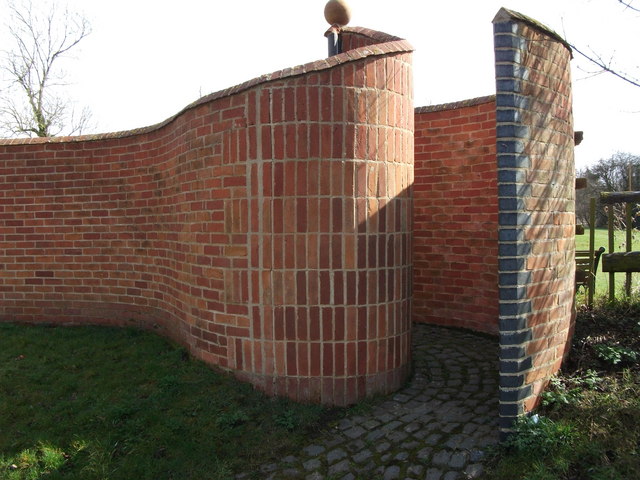Crinkle crankle wall
|
This crinkle crankle wall and curved gateway leads to private gardens. Inside this entrance there is a curved gate to match the wall. |
Pevsner’s Architectural Glossary (second edition) was published by Yale University Press in 2018. It defines a crinkle crankle wall as: ‘A garden wall undulating in a series of serpentine curves, especially in Suffolk’. This type of serpentine wall is also referred to as crinkum crankum, sinusoidal, ribbon or wavy wall. The term crinkle crankle was used in the late 1500s to describe an object with bends; it became associated with wavy walls in England in the 1700s.
In addition to being found in gardens (where they were sometimes used for growing fruit), crinkle crankle walls may have defensive purposes or may demarcate property boundaries.
A form of construction incorporating alternating curves was used in Ancient Egypt. It was also used by Thomas Jefferson at the University of Virginia. The technique typically requires less material than a traditional, straight wall, as the walls do not use mass to achieve lateral stability.
[edit] Related articles on Designing Buildings Wiki
Featured articles and news
Latest Build UK Building Safety Regime explainer published
Key elements in one short, now updated document.
UKGBC launch the UK Climate Resilience Roadmap
First guidance of its kind on direct climate impacts for the built environment and how it can adapt.
CLC Health, Safety and Wellbeing Strategy 2025
Launched by the Minister for Industry to look at fatalities on site, improving mental health and other issues.
One of the most impressive Victorian architects. Book review.
Common Assessment Standard now with building safety
New CAS update now includes mandatory building safety questions.
RTPI leader to become new CIOB Chief Executive Officer
Dr Victoria Hills MRTPI, FICE to take over after Caroline Gumble’s departure.
Social and affordable housing, a long term plan for delivery
The “Delivering a Decade of Renewal for Social and Affordable Housing” strategy sets out future path.
A change to adoptive architecture
Effects of global weather warming on architectural detailing, material choice and human interaction.
The proposed publicly owned and backed subsidiary of Homes England, to facilitate new homes.
How big is the problem and what can we do to mitigate the effects?
Overheating guidance and tools for building designers
A number of cool guides to help with the heat.
The UK's Modern Industrial Strategy: A 10 year plan
Previous consultation criticism, current key elements and general support with some persisting reservations.
Building Safety Regulator reforms
New roles, new staff and a new fast track service pave the way for a single construction regulator.
Architectural Technologist CPDs and Communications
CIAT CPD… and how you can do it!
Cooling centres and cool spaces
Managing extreme heat in cities by directing the public to places for heat stress relief and water sources.
Winter gardens: A brief history and warm variations
Extending the season with glass in different forms and terms.
Restoring Great Yarmouth's Winter Gardens
Transforming one of the least sustainable constructions imaginable.























